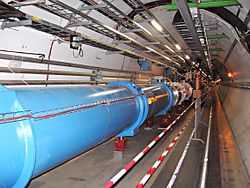Pentaquark
| Standard Model of particle physics |
|---|
 Large Hadron Collider tunnel at CERN |
|
Constituents |
|
Limitations |
|
Scientists Rutherford · Thomson · Chadwick · Bose · Sudarshan · Koshiba · Davis, Jr. · Anderson · Fermi · Dirac · Feynman · Rubbia · Gell-Mann · Kendall · Taylor · Friedman · Powell · P. W. Anderson · Glashow · Meer · Cowan · Nambu · Chamberlain · Cabibbo · Schwartz · Perl · Majorana · Weinberg · Lee · Ward · Salam · Kobayashi · Maskawa · Yang · Yukawa · 't Hooft · Veltman · Gross · Politzer · Wilczek · Cronin · Fitch · Vleck · Higgs · Englert · Brout · Hagen · Guralnik · Kibble · Ting · Richter |
A pentaquark is a hypothetical subatomic particle consisting of four quarks and one antiquark bound together (compared to three quarks in normal baryons). As quarks have a baryon number of +1⁄3, and antiquarks of −1⁄3, it would have a total baryon number of 1, thus being classified as an exotic baryon. The existence of pentaquarks was originally hypothesized by Michał Praszałowicz in 1987.[1]
Several experiments reported the existence of pentaquark states in the mid-2000s, but later experiments and re-analysis of the data showed them to be statistical effects rather than true resonances.
History
In the mid-2000s, several experiments claimed to reveal pentaquark states. In particular, a resonance with a mass of 1540 MeV/c2 (4.6 σ) was reported by LEPS in 2003, the Θ+.[2] This coincided with a pentaquark state with a mass of 1530 MeV/c2 predicted in 1997 by Dmitri Diakonov, Victor Petrov, and Maxim Polyakov.[3]
This state was presumably composed of two up quarks, two down quarks, and one strange antiquark (uudds). Following this announcement, nine other independent experiments reported seeing narrow peaks from nK+ and pK0, with masses between 1522 MeV/c2 and 1555 MeV/c2, all above 4 σ.[2] While concerns existed about the validity of these states, the Particle Data Group gave the Θ+ a 3-star rating (out of 4) in the 2004 Review of Particle Physics.[2] Two other pentaquark states were reported albeit with low statistical significance—the Φ−− (ddssu), with a mass of 1860 MeV/c2 and the Θ0
c (uuddc), with a mass of 3099 MeV/c2. Both were later found to be statistical effects rather than true resonances.[2]
Ten experiments then looked for the Θ+, but came out empty-handed.[2] Two in particular (one at BELLE, and the other at CLAS) had nearly the same conditions as other experiments which claimed to have detected the Θ+ (DIANA and SAPHIR respectively).[2] The 2006 Review of Particle Physics concluded:[2]
[T]here has not been a high-statistics confirmation of any of the original experiments that claimed to see the Θ+; there have been two high-statistics repeats from Jefferson Lab that have clearly shown the original positive claims in those two cases to be wrong; there have been a number of other high-statistics experiments, none of which have found any evidence for the Θ+; and all attempts to confirm the two other claimed pentaquark states have led to negative results. The conclusion that pentaquarks in general, and the Θ+, in particular, do not exist, appears compelling.
The 2008 Review of Particle Physics went even further:[4]
There are two or three recent experiments that find weak evidence for signals near the nominal masses, but there is simply no point in tabulating them in view of the overwhelming evidence that the claimed pentaquarks do not exist... The whole story—the discoveries themselves, the tidal wave of papers by theorists and phenomenologists that followed, and the eventual "undiscovery"—is a curious episode in the history of science.
Despite these null results, LEPS results as of 2009 continue to show the existence of a narrow state with a mass of 1524±4 MeV/c2, with a statistical significance of 5.1 σ.[5] Experiments continue to study this controversy.
See also
References
- ↑ M. Praszałowicz (1987). M. Jeżabek, M. Praszałowicz, ed. Proceedings of the Workshop on Skyrmions and Anomalies, Krakow, Poland, 1987. World Scientific. p. 112.
- ↑ 2.0 2.1 2.2 2.3 2.4 2.5 2.6 W.-M. Yao et al. (Particle Data Group) (2006). "Review of Particle Physics: Θ+" (PDF). Journal of Physics G 33: 1. arXiv:astro-ph/0601168. Bibcode:2006JPhG...33....1Y. doi:10.1088/0954-3899/33/1/001.
- ↑ D. Diakonov, V. Petrov, and M. Polyakov (1997). "Exotic anti-decuplet of baryons: prediction from chiral solitons". Zeitschrift für Physik A 359 (3): 305. arXiv:hep-ph/9703373. Bibcode:1997ZPhyA.359..305D. doi:10.1007/s002180050406.
- ↑ Particle Data Group (2008). "Baryons". Physics Letters B 667: 1061–1206. Bibcode:2008PhLB..667....1P. doi:10.1016/j.physletb.2008.07.044.
- ↑ T. Nakano et al. (LEPS Collaboration) (2009). "Evidence of the Θ+ in the γd → K+K−pn reaction". Physical Review C 79 (2): 025210. arXiv:0812.1035. Bibcode:2009PhRvC..79b5210N. doi:10.1103/PhysRevC.79.025210.
Further reading
- David Whitehouse (1 July 2003). "Behold the Pentaquark (BBC News)". BBC News. Retrieved 2010-01-08.
- Hazel Muir (2 July 2003). "Pentaquark discovery confounds sceptics". New Scientist. Retrieved 2010-01-08.
- Kenneth Hicks (23 July 2003). "Physicists Find Evidence for an Exotic Baryon". Ohio University. Retrieved 2010-01-08.
- Thomas E. Browder, Igor R. Klebanov, Daniel R. Marlow (2004). "Prospects for Pentaquark Production at Meson Factories". Physics Letters B 587: 62. arXiv:hep-ph/0401115. Bibcode:2004PhLB..587...62B. doi:10.1016/j.physletb.2004.03.003.
- Akio Sugamoto (2004). "An Attempt to Study Pentaquark Baryons in String Theory". arXiv:hep-ph/0404019 [hep-ph].
- Kenneth Hicks (2005). "An Experimental Review of the Θ+ Pentaquark". Journal of Physics: Conference Series 9: 183. arXiv:hep-ex/0412048. Bibcode:2005JPhCS...9..183H. doi:10.1088/1742-6596/9/1/035.
- Mark Peplow (18 April 2005). "Doubt is Cast on Pentaquarks". Nature. doi:10.1038/news050418-1.
- Maggie McKie (20 April 2005). "Pentaquark hunt draws blanks". New Scientist. Retrieved 2010-01-08.
- Jefferson Lab (21 April 2005). "Is It Or Isn't It? Pentaquark Debate Heats Up". Space Daily. Retrieved 2010-01-08.
- Dmitri Diakonov (2005). "Relativistic Mean Field Approximation to Baryons". European Physical Journal A 24: 3. Bibcode:2005EPJAS..24a...3D. doi:10.1140/epjad/s2005-05-001-3.
- Schumacher, R. A. (2006). "The Rise and Fall of Pentaquarks in Experiments". AIP Conference Proceedings 842: 409. arXiv:nucl-ex/0512042. doi:10.1063/1.2220285.
- Kandice Carter (2006). "The Rise and Fall of the Pentaquark". Symmetry Magazine 3 (7): 16.
External links
| ||||||||||||||||||||||||||||||||||||||||||||||||||||||||||||||||||||||||||||||||||||||||||||